key HUMMER H2 2009 Owners Manual
[x] Cancel search | Manufacturer: HUMMER, Model Year: 2009, Model line: H2, Model: HUMMER H2 2009Pages: 524, PDF Size: 3.1 MB
Page 1 of 524
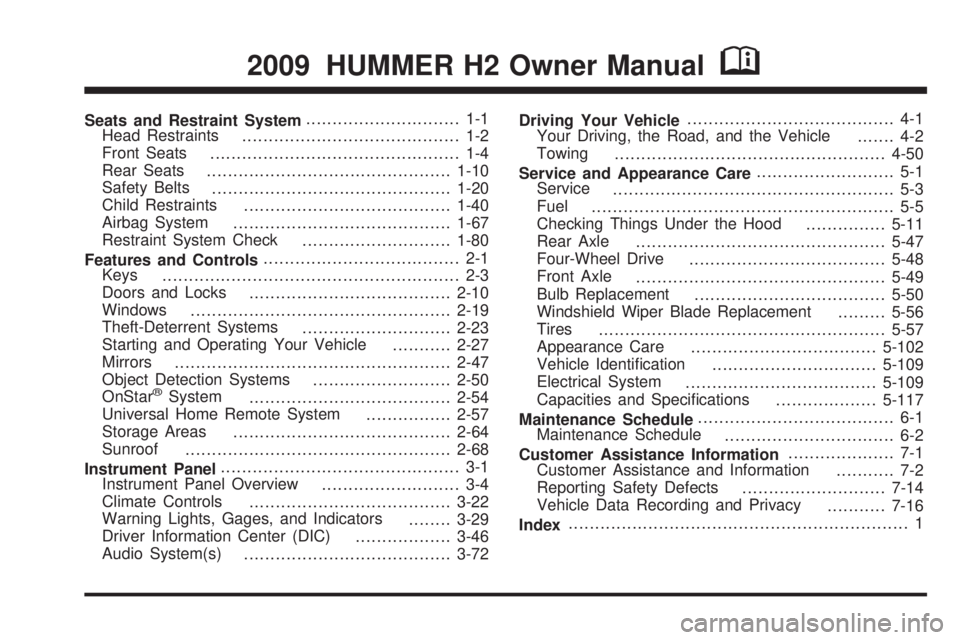
Seats and Restraint System............................. 1-1
Head Restraints
......................................... 1-2
Front Seats
............................................... 1-4
Rear Seats
..............................................1-10
Safety Belts
.............................................1-20
Child Restraints
.......................................1-40
Airbag System
.........................................1-67
Restraint System Check
............................1-80
Features and Controls..................................... 2-1
Keys
........................................................ 2-3
Doors and Locks
......................................2-10
Windows
.................................................2-19
Theft-Deterrent Systems
............................2-23
Starting and Operating Your Vehicle
...........2-27
Mirrors
....................................................2-47
Object Detection Systems
..........................2-50
OnStar
®System
......................................2-54
Universal Home Remote System
................2-57
Storage Areas
.........................................2-64
Sunroof
..................................................2-68
Instrument Panel............................................. 3-1
Instrument Panel Overview
.......................... 3-4
Climate Controls
......................................3-22
Warning Lights, Gages, and Indicators
........3-29
Driver Information Center (DIC)
..................3-46
Audio System(s)
.......................................3-72Driving Your Vehicle....................................... 4-1
Your Driving, the Road, and the Vehicle
....... 4-2
Towing
...................................................4-50
Service and Appearance Care.......................... 5-1
Service
..................................................... 5-3
Fuel
......................................................... 5-5
Checking Things Under the Hood
...............5-11
Rear Axle
...............................................5-47
Four-Wheel Drive
.....................................5-48
Front Axle
...............................................5-49
Bulb Replacement
....................................5-50
Windshield Wiper Blade Replacement
.........5-56
Tires
......................................................5-57
Appearance Care
...................................5-102
Vehicle Identi�cation
...............................5-109
Electrical System
....................................5-109
Capacities and Speci�cations
...................5-117
Maintenance Schedule..................................... 6-1
Maintenance Schedule
................................ 6-2
Customer Assistance Information.................... 7-1
Customer Assistance and Information
........... 7-2
Reporting Safety Defects
...........................7-14
Vehicle Data Recording and Privacy
...........7-16
Index................................................................ 1
2009 HUMMER H2 Owner ManualM
Page 11 of 524
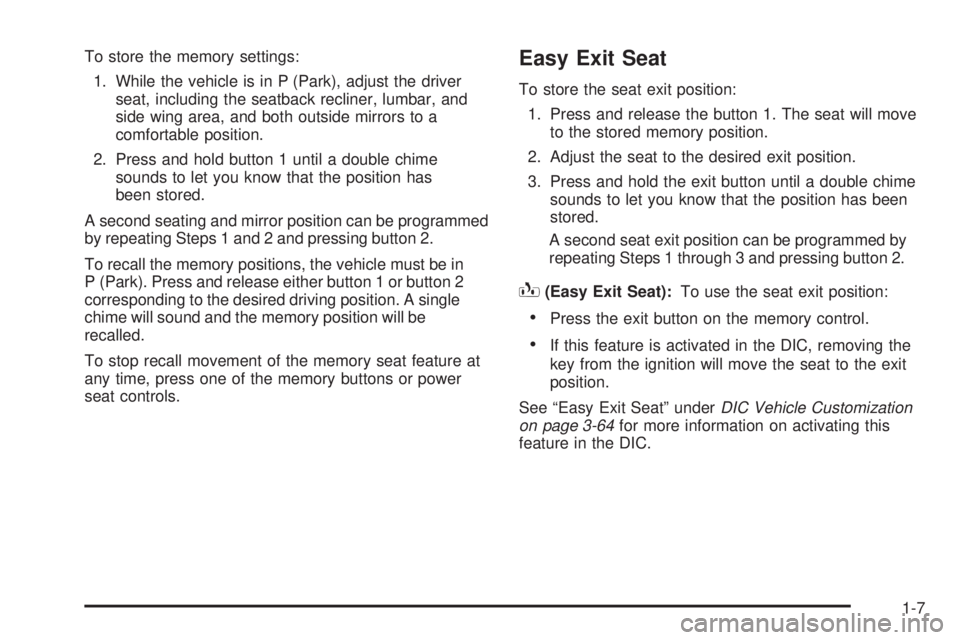
To store the memory settings:
1. While the vehicle is in P (Park), adjust the driver
seat, including the seatback recliner, lumbar, and
side wing area, and both outside mirrors to a
comfortable position.
2. Press and hold button 1 until a double chime
sounds to let you know that the position has
been stored.
A second seating and mirror position can be programmed
by repeating Steps 1 and 2 and pressing button 2.
To recall the memory positions, the vehicle must be in
P (Park). Press and release either button 1 or button 2
corresponding to the desired driving position. A single
chime will sound and the memory position will be
recalled.
To stop recall movement of the memory seat feature at
any time, press one of the memory buttons or power
seat controls.Easy Exit Seat
To store the seat exit position:
1. Press and release the button 1. The seat will move
to the stored memory position.
2. Adjust the seat to the desired exit position.
3. Press and hold the exit button until a double chime
sounds to let you know that the position has been
stored.
A second seat exit position can be programmed by
repeating Steps 1 through 3 and pressing button 2.
B(Easy Exit Seat):To use the seat exit position:
Press the exit button on the memory control.
If this feature is activated in the DIC, removing the
key from the ignition will move the seat to the exit
position.
See “Easy Exit Seat” underDIC Vehicle Customization
on page 3-64for more information on activating this
feature in the DIC.
1-7
Page 43 of 524

Safety Belt Use During Pregnancy
Safety belts work for everyone, including pregnant
women. Like all occupants, they are more likely to be
seriously injured if they do not wear safety belts.
A pregnant woman should wear a lap-shoulder belt, and
the lap portion should be worn as low as possible,
below the rounding, throughout the pregnancy.
The best way to protect the fetus is to protect the
mother. When a safety belt is worn properly, it is more
likely that the fetus will not be hurt in a crash. For
pregnant women, as for anyone, the key to making
safety belts effective is wearing them properly.
Safety Belt Extender
If the safety belt will fasten around you, you should
use it.
But if a safety belt is not long enough, your dealer/retailer
will order you an extender. When you go in to order it,
take the heaviest coat you will wear, so the extender will
be long enough for you. To help avoid personal injury, do
not let someone else use it, and use it only for the seat it
is made to �t. The extender has been designed for adults.
Never use it for securing child seats. To wear it, attach it
to the regular safety belt. For more information, see the
instruction sheet that comes with the extender.
1-39
Page 81 of 524

Medical Condition.A passenger has a
medical condition which, according to his or
her physician:
Causes the passenger airbag to pose a special risk
for the passenger; and
Makes the potential harm from the passenger
airbag in a crash greater than the potential
harm from turning off the airbag and allowing the
passenger, even if belted, to hit the dashboard
or windshield in a crash.
{CAUTION:
If the right front passenger’s airbag is turned off
for a person who is not in a risk group identi�ed
by the national government, that person will not
have the extra protection of an airbag. In a crash,
the airbag will not be able to in�ate and help
protect the person sitting there. Do not turn off the
passenger’s airbag unless the person sitting there
is in a risk group.To turn off the right front passenger frontal airbag, insert
the ignition key into the switch, push in, and move the
switch to the off position.
The word OFF or the off symbol will come on in the
passenger airbag status indicator located in the
overhead console to let you know that the right front
passenger airbag is off, after the system check is
completed. The airbag off light will come on and stay on
to let you know that the right front passenger airbag
is off. SeeAirbag Off Light on page 3-33. United States
Canada
1-77
Page 82 of 524

The airbag off light will stay on to remind you that the
airbag is off. The right front passenger airbag will remain
off until you turn it back on again.
{CAUTION:
If the airbag readiness light ever comes on and
stays on, it means that something may be wrong
with the airbag system. For example, the right
front passenger airbag could in�ate even though
the airbag on-off switch is turned off.
To help avoid injury to yourself or others, have the
vehicle serviced right away. SeeAirbag Readiness
Light on page 3-32for more information, including
important safety information.To turn the right front passenger airbag on again, insert
the ignition key into the switch, push in, and move
the switch to the on position.
The right front passenger’s frontal airbag is now
enabled (may in�ate). SeeAirbag Off Light on page 3-33
for more information.United States
Canada
1-78
Page 87 of 524
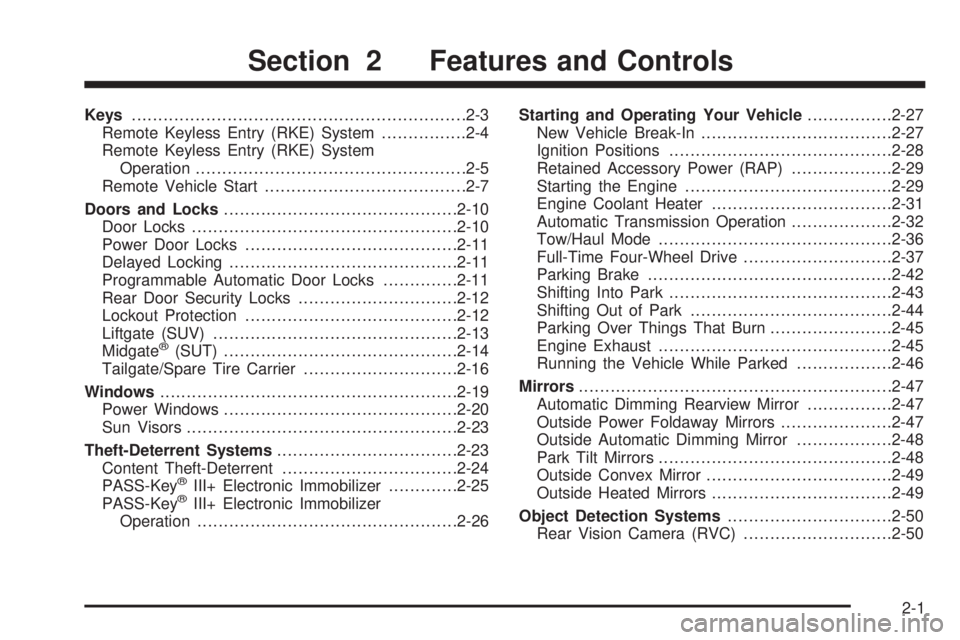
Keys...............................................................2-3
Remote Keyless Entry (RKE) System................2-4
Remote Keyless Entry (RKE) System
Operation...................................................2-5
Remote Vehicle Start......................................2-7
Doors and Locks............................................2-10
Door Locks..................................................2-10
Power Door Locks........................................2-11
Delayed Locking...........................................2-11
Programmable Automatic Door Locks..............2-11
Rear Door Security Locks..............................2-12
Lockout Protection........................................2-12
Liftgate (SUV)..............................................2-13
Midgate
®(SUT) ............................................2-14
Tailgate/Spare Tire Carrier.............................2-16
Windows........................................................2-19
Power Windows............................................2-20
Sun Visors...................................................2-23
Theft-Deterrent Systems..................................2-23
Content Theft-Deterrent.................................2-24
PASS-Key
®III+ Electronic Immobilizer.............2-25
PASS-Key®III+ Electronic Immobilizer
Operation.................................................2-26Starting and Operating Your Vehicle................2-27
New Vehicle Break-In....................................2-27
Ignition Positions..........................................2-28
Retained Accessory Power (RAP)...................2-29
Starting the Engine.......................................2-29
Engine Coolant Heater..................................2-31
Automatic Transmission Operation...................2-32
Tow/Haul Mode............................................2-36
Full-Time Four-Wheel Drive............................2-37
Parking Brake..............................................2-42
Shifting Into Park..........................................2-43
Shifting Out of Park......................................2-44
Parking Over Things That Burn.......................2-45
Engine Exhaust............................................2-45
Running the Vehicle While Parked..................2-46
Mirrors...........................................................2-47
Automatic Dimming Rearview Mirror................2-47
Outside Power Foldaway Mirrors.....................2-47
Outside Automatic Dimming Mirror..................2-48
Park Tilt Mirrors............................................2-48
Outside Convex Mirror...................................2-49
Outside Heated Mirrors..................................2-49
Object Detection Systems...............................2-50
Rear Vision Camera (RVC)............................2-50
Section 2 Features and Controls
2-1
Page 89 of 524

Keys
{CAUTION:
Leaving children in a vehicle with the ignition key
is dangerous for many reasons, children or others
could be badly injured or even killed. They could
operate the power windows or other controls or
even make the vehicle move. The windows will
function with the keys in the ignition and children
could be seriously injured or killed if caught in the
path of a closing window. Do not leave the keys in
a vehicle with children.
The key can be used for the ignition and all door locks.
The key has a bar-coded key tag that the dealer/retailer
or quali�ed locksmith can use to make new keys.
Store this information in a safe place, not in your vehicle.
See your dealer/retailer if a replacement key or
additional key is needed.
Notice:If you ever lock your keys in the vehicle,
you may have to damage the vehicle to get in.
Be sure you have spare keys.
If you are locked out of your vehicle, call the Roadside
Assistance Center. SeeRoadside Service on page 7-7.
2-3
Page 90 of 524

Remote Keyless Entry (RKE)
System
The Remote Keyless Entry (RKE) system operates on
a radio frequency subject to Federal Communications
Commission (FCC) Rules and with Industry Canada.
This device complies with Part 15 of the FCC Rules.
Operation is subject to the following two conditions:
1. This device may not cause interference.
2. This device must accept any interference received,
including interference that may cause undesired
operation of the device.
This device complies with RSS-210 of Industry Canada.
Operation is subject to the following two conditions:
1. This device may not cause interference.
2. This device must accept any interference received,
including interference that may cause undesired
operation of the device.Changes or modi�cations to this system by other than
an authorized service facility could void authorization to
use this equipment.
If there is a decrease in the RKE operating range,
try this:
Check the distance. The transmitter may be too far
from the vehicle. Stand closer during rainy or snowy
weather.
Check the location. Other vehicles or objects may be
blocking the signal. Take a few steps to the left or
right, hold the transmitter higher, and try again.
Check the transmitter’s battery. See “Battery
Replacement” later in this section.
If the transmitter is still not working correctly, see
your dealer/retailer or a quali�ed technician for
service.
2-4
Page 91 of 524
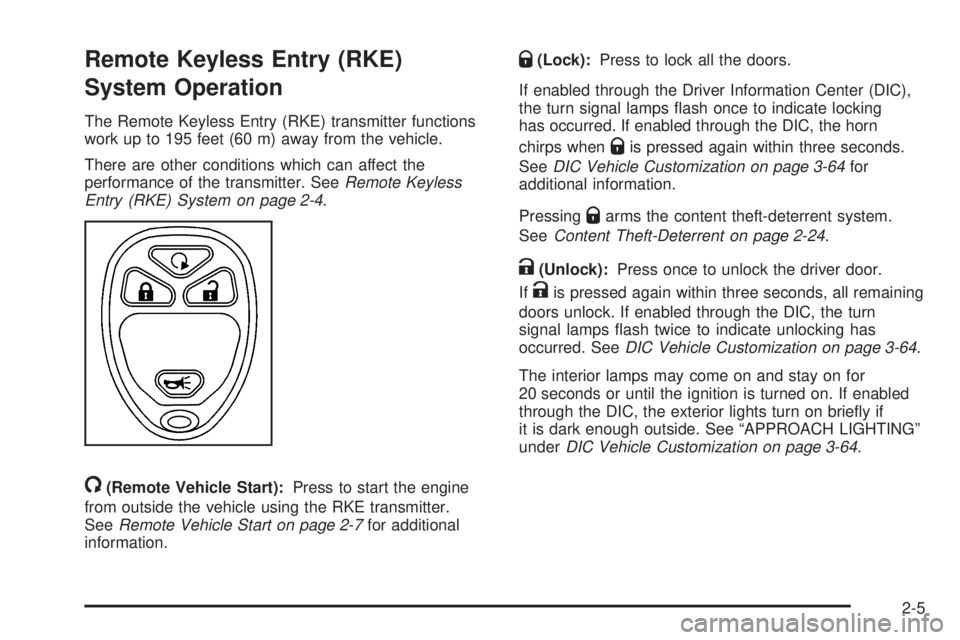
Remote Keyless Entry (RKE)
System Operation
The Remote Keyless Entry (RKE) transmitter functions
work up to 195 feet (60 m) away from the vehicle.
There are other conditions which can affect the
performance of the transmitter. SeeRemote Keyless
Entry (RKE) System on page 2-4.
/(Remote Vehicle Start):Press to start the engine
from outside the vehicle using the RKE transmitter.
SeeRemote Vehicle Start on page 2-7for additional
information.
Q(Lock):Press to lock all the doors.
If enabled through the Driver Information Center (DIC),
the turn signal lamps �ash once to indicate locking
has occurred. If enabled through the DIC, the horn
chirps when
Qis pressed again within three seconds.
SeeDIC Vehicle Customization on page 3-64for
additional information.
Pressing
Qarms the content theft-deterrent system.
SeeContent Theft-Deterrent on page 2-24.
K(Unlock):Press once to unlock the driver door.
If
Kis pressed again within three seconds, all remaining
doors unlock. If enabled through the DIC, the turn
signal lamps �ash twice to indicate unlocking has
occurred. SeeDIC Vehicle Customization on page 3-64.
The interior lamps may come on and stay on for
20 seconds or until the ignition is turned on. If enabled
through the DIC, the exterior lights turn on brie�y if
it is dark enough outside. See “APPROACH LIGHTING”
underDIC Vehicle Customization on page 3-64.
2-5
Page 92 of 524
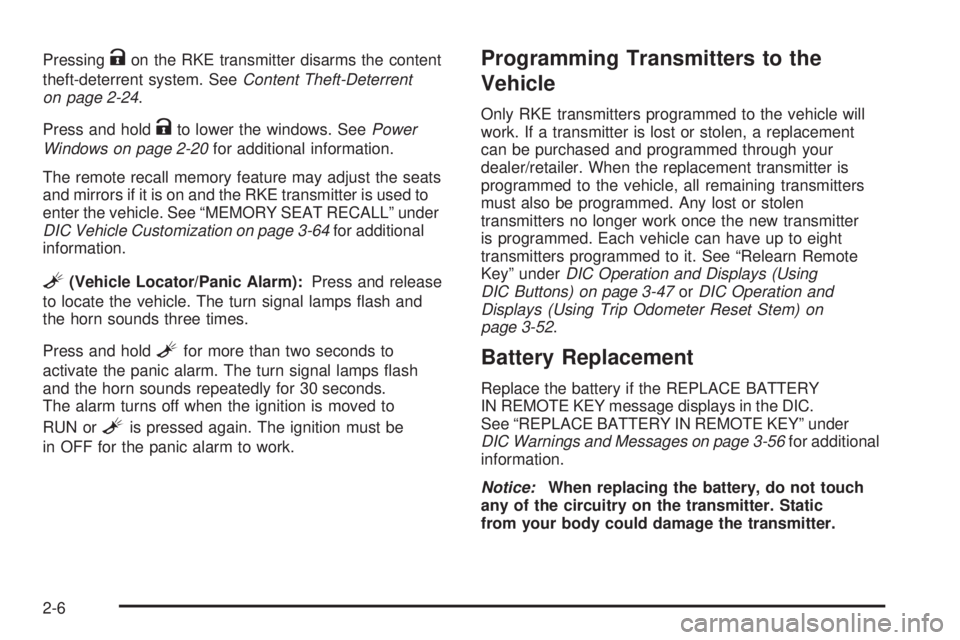
PressingKon the RKE transmitter disarms the content
theft-deterrent system. SeeContent Theft-Deterrent
on page 2-24.
Press and hold
Kto lower the windows. SeePower
Windows on page 2-20for additional information.
The remote recall memory feature may adjust the seats
and mirrors if it is on and the RKE transmitter is used to
enter the vehicle. See “MEMORY SEAT RECALL” under
DIC Vehicle Customization on page 3-64for additional
information.
L(Vehicle Locator/Panic Alarm):Press and release
to locate the vehicle. The turn signal lamps �ash and
the horn sounds three times.
Press and hold
Lfor more than two seconds to
activate the panic alarm. The turn signal lamps �ash
and the horn sounds repeatedly for 30 seconds.
The alarm turns off when the ignition is moved to
RUN or
Lis pressed again. The ignition must be
in OFF for the panic alarm to work.
Programming Transmitters to the
Vehicle
Only RKE transmitters programmed to the vehicle will
work. If a transmitter is lost or stolen, a replacement
can be purchased and programmed through your
dealer/retailer. When the replacement transmitter is
programmed to the vehicle, all remaining transmitters
must also be programmed. Any lost or stolen
transmitters no longer work once the new transmitter
is programmed. Each vehicle can have up to eight
transmitters programmed to it. See “Relearn Remote
Key” underDIC Operation and Displays (Using
DIC Buttons) on page 3-47orDIC Operation and
Displays (Using Trip Odometer Reset Stem) on
page 3-52.
Battery Replacement
Replace the battery if the REPLACE BATTERY
IN REMOTE KEY message displays in the DIC.
See “REPLACE BATTERY IN REMOTE KEY” under
DIC Warnings and Messages on page 3-56for additional
information.
Notice:When replacing the battery, do not touch
any of the circuitry on the transmitter. Static
from your body could damage the transmitter.
2-6